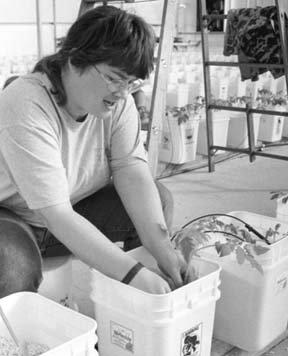 Hydroponic gardening, a method of gardening without soil, dates back to the 1800s. However, it is a relatively new method of gardening to Joachim (Jo) and Kelly Speldrich.
Hydroponic gardening, a method of gardening without soil, dates back to the 1800s. However, it is a relatively new method of gardening to Joachim (Jo) and Kelly Speldrich.Jo and Kelly, whose business is called K&J Greenhouse, experimented in raising tomato plants hydroponically last winter. Kelly, a master gardener, spent more than a year studying hydroponic gardening. Last year they raised 90 tomato plants in a small greenhouse at their place in Regal.
"Our tomato crop turned out better than we thought it would," Kelly said. They sold the tomatoes to local grocery stores.
According to Richard E. Nicholls, author of Beginning Hydroponics, hydroponics is the term used to describe several ways in which plants can be raised without soil. These methods include raising plants in containers filled with water and: gravel, sand, vermiculite, crushed cinder blocks, or styrofoam.
Nicholls says almost any kind of plant can be grown hydroponically: flowers and foliage plants, fruits, herbs, and vegetables.
This winter, the Speldriches expanded their hydroponic gardening experiment. At their new home on Cemetery Road, west of Paynesville, they erected a two-bay 62- by 130-foot plastic greenhouse in September. The plastic is six millimeters thick with an air pocket in-between.
When referring to the size of the new greenhouse, Kelly likes to tease Jo that he blew the project out of proportion.
Kelly and her sister-in-law, Michelle, were busy at the end of January planting 1,800 seedlings in five-gallon pails, two plants per pail. (See photo above.) The tomato seedlings were started in a separate nursery building located next to the greenhouse. The seeds are designed for low light facilities.
Each pail is filled with perlite, small granulars of expanded volcanic minerals. A small water hose will spray water into the perlite for four seconds every hour and a half to two hours. As the plants grow bigger, they will receive water every seven seconds.
The excess water drains from the pails through a pipe that carries the water to a holding tank. The Speldriches use it to water their lawn and outside plants. "We get about 60 gallons of excess water per day," Kelly said.
Within two and a half months, the Speldriches expect to be picking tomatoes. The plants should produce tomatoes for 10 months. Each plant is expected to produce about one pound of tomatoes per week when mature.
Raising plants in a nonsoil medium allows you to grow more plants in a limited space, conserve water and fertilizer, exert greater control over your plants, and insure more uniform results, Nicholls said in his book.
The Speldriches' plants will grow to 25 feet high. The greenhouse has a heavy string suspended from the ceiling to support the vines.
Once the plant's life span is completed, the Speldriches will clean out the greenhouse and put the tomato plants and perlite in a compost pile. They will then wash and sanitize the building with bleach before replanting the pails with new plants.
The daytime temperature in the green-house averages 72 to 78 degrees. At night, when the sun goes down, the temperature will drop to 68 degrees. There is an alarm system in the green-house to alert the Speldriches when the temperature drops too low or raises too high, which would harm the plants. The Speldriches' first planting of tomatoes froze in December and they had to replant everything.
During the summer months, a fine mist in the building will keep the temperature cooler. Large exhaust fans will help circulate the air. The fans will also help keep mold from forming on the plants.
Organically grown
Kelly said they grow the tomatoes organically.
Synthetic fertilizer is applied to the plants through the water system. The strength of fertilizer changes as the plant grows and requires more nutrients.
Unlike plants growing outdoors, exposed to nature, the plants in the greenhouse need a little help to pollinate. "We plan on purchasing bees to pollinate the tomato plants," Kelly said. "The hives are placed in the corners of the greenhouse. The bees stay in the boxes most of the day. They seem to do their work in the morning and evening hours when the air is less humid."
Jo will be checking the plants to ensure that they have been pollinated. If the plants appear to be unpollinated, he will pollinate them by hand, using pollen from the tomato plants.
Kelly warned that when you enter the greenhouse, don't wear any perfume, hair spray, or the color yellow as that will attract the bees to you.
The greenhouse floor will be heated eventually. It is presently a concrete slab. "We were going to start with a dirt floor until we learned 80 percent of your insects live in the dirt," Kelly said. "(Cement) is cleaner and easier to keep bugs out of the greenhouse."
Growing plants in a soilless medium eliminates the possibility of soil-borne pests or diseases ravaging your crops or plants. It also eliminates the need to rely on insecticides, Nicholls writes in his book.
Before planting the seedlings, Kelly and Michelle painstakingly checked each plant individually, taking off the first leaves and the yellowed leaves. "We didn't want to bring any parasites into the greenhouse," Kelly said.